Blog & Latest Updates
Fly Fishing Articles
Insects by Common Name


> > Miscellaneous
Closeup insects from Miscellaneous
Simuliidae (Black Flies) Black Fly Larva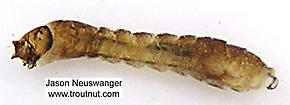 View 4 Pictures
View 4 Pictures
 View 4 Pictures
View 4 PicturesCollected March 1, 2004 from unknown in Wisconsin
Added to Troutnut.com by Troutnut on January 25, 2006
Added to Troutnut.com by Troutnut on January 25, 2006
Maccaffertium modestum (Cream Cahill) Mayfly Nymph View 4 Pictures
View 4 Pictures
 View 4 Pictures
View 4 PicturesCollected January 19, 2004 from unknown in Wisconsin
Added to Troutnut.com by Troutnut on January 25, 2006
Added to Troutnut.com by Troutnut on January 25, 2006
Siphloplecton basale (Pseudo-Gray Drake) Mayfly Nymph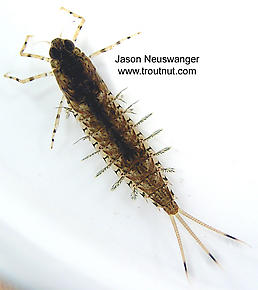 View 4 PicturesThis nymph has double front tarsal claws (Tarsal claw: The claws at the tip of the tarsus, on an insect's "foot.") and double gills on the first three abdominal segments.
View 4 PicturesThis nymph has double front tarsal claws (Tarsal claw: The claws at the tip of the tarsus, on an insect's "foot.") and double gills on the first three abdominal segments.
 View 4 PicturesThis nymph has double front tarsal claws (Tarsal claw: The claws at the tip of the tarsus, on an insect's "foot.") and double gills on the first three abdominal segments.
View 4 PicturesThis nymph has double front tarsal claws (Tarsal claw: The claws at the tip of the tarsus, on an insect's "foot.") and double gills on the first three abdominal segments.Collected March 1, 2004 from unknown in Wisconsin
Added to Troutnut.com by Troutnut on January 25, 2006
Added to Troutnut.com by Troutnut on January 25, 2006
Isoperla (Stripetails and Yellow Stones) Stonefly Nymph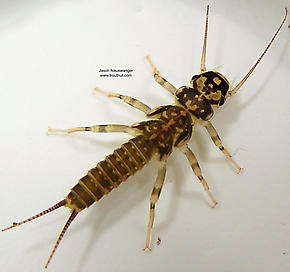 View 4 Pictures
View 4 Pictures
 View 4 Pictures
View 4 PicturesCollected March 9, 2004 from unknown in Wisconsin
Added to Troutnut.com by Troutnut on January 25, 2006
Added to Troutnut.com by Troutnut on January 25, 2006
Cordulegaster Dragonfly Nymph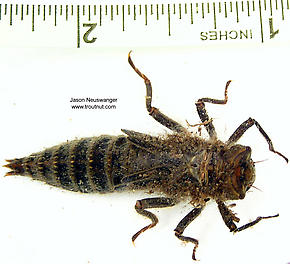 View 4 Pictures
View 4 Pictures
 View 4 Pictures
View 4 PicturesCollected March 1, 2004 from unknown in Wisconsin
Added to Troutnut.com by Troutnut on January 25, 2006
Added to Troutnut.com by Troutnut on January 25, 2006
Limnephilidae (Northern Caddisflies) Caddisfly Larva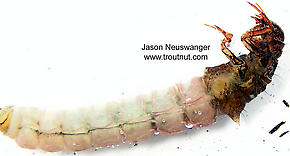 View 4 Pictures
View 4 Pictures
 View 4 Pictures
View 4 PicturesCollected March 1, 2004 from unknown in Wisconsin
Added to Troutnut.com by Troutnut on January 25, 2006
Added to Troutnut.com by Troutnut on January 25, 2006
Chimarra (Little Black Sedges) Caddisfly Larva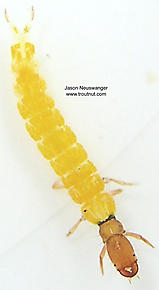 View 4 Pictures
View 4 Pictures
 View 4 Pictures
View 4 PicturesCollected March 1, 2004 from unknown in Wisconsin
Added to Troutnut.com by Troutnut on January 25, 2006
Added to Troutnut.com by Troutnut on January 25, 2006
Hagenius brevistylus Dragonfly Nymph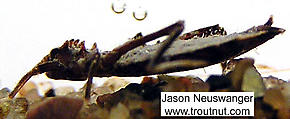 View 4 Pictures
View 4 Pictures
 View 4 Pictures
View 4 PicturesCollected March 1, 2004 from unknown in Wisconsin
Added to Troutnut.com by Troutnut on January 25, 2006
Added to Troutnut.com by Troutnut on January 25, 2006
Female Hydropsyche (Spotted Sedges) Caddisfly Adult View 4 Pictures
View 4 Pictures
 View 4 Pictures
View 4 PicturesCollected May 16, 2004 from unknown in Wisconsin
Added to Troutnut.com by Troutnut on January 25, 2006
Added to Troutnut.com by Troutnut on January 25, 2006
Siphloplecton basale (Pseudo-Gray Drake) Mayfly Nymph View 4 PicturesThis nymph has double front tarsal claws (Tarsal claw: The claws at the tip of the tarsus, on an insect's "foot.") and double gills on the first three abdominal segments.
View 4 PicturesThis nymph has double front tarsal claws (Tarsal claw: The claws at the tip of the tarsus, on an insect's "foot.") and double gills on the first three abdominal segments.
 View 4 PicturesThis nymph has double front tarsal claws (Tarsal claw: The claws at the tip of the tarsus, on an insect's "foot.") and double gills on the first three abdominal segments.
View 4 PicturesThis nymph has double front tarsal claws (Tarsal claw: The claws at the tip of the tarsus, on an insect's "foot.") and double gills on the first three abdominal segments.Collected March 1, 2004 from unknown in Wisconsin
Added to Troutnut.com by Troutnut on January 25, 2006
Added to Troutnut.com by Troutnut on January 25, 2006
Start a Discussion of Miscellaneous:
Top 10 Fly Hatches
Top Gift Shop Designs
Eat mayflies.
Top Insect Specimens
Miscellaneous Sites
Troutnut.com is copyright © 2004-2024 Jason
Neuswanger (email Jason). See my FAQ for information about use of my images.
 privacy policy
privacy policy
